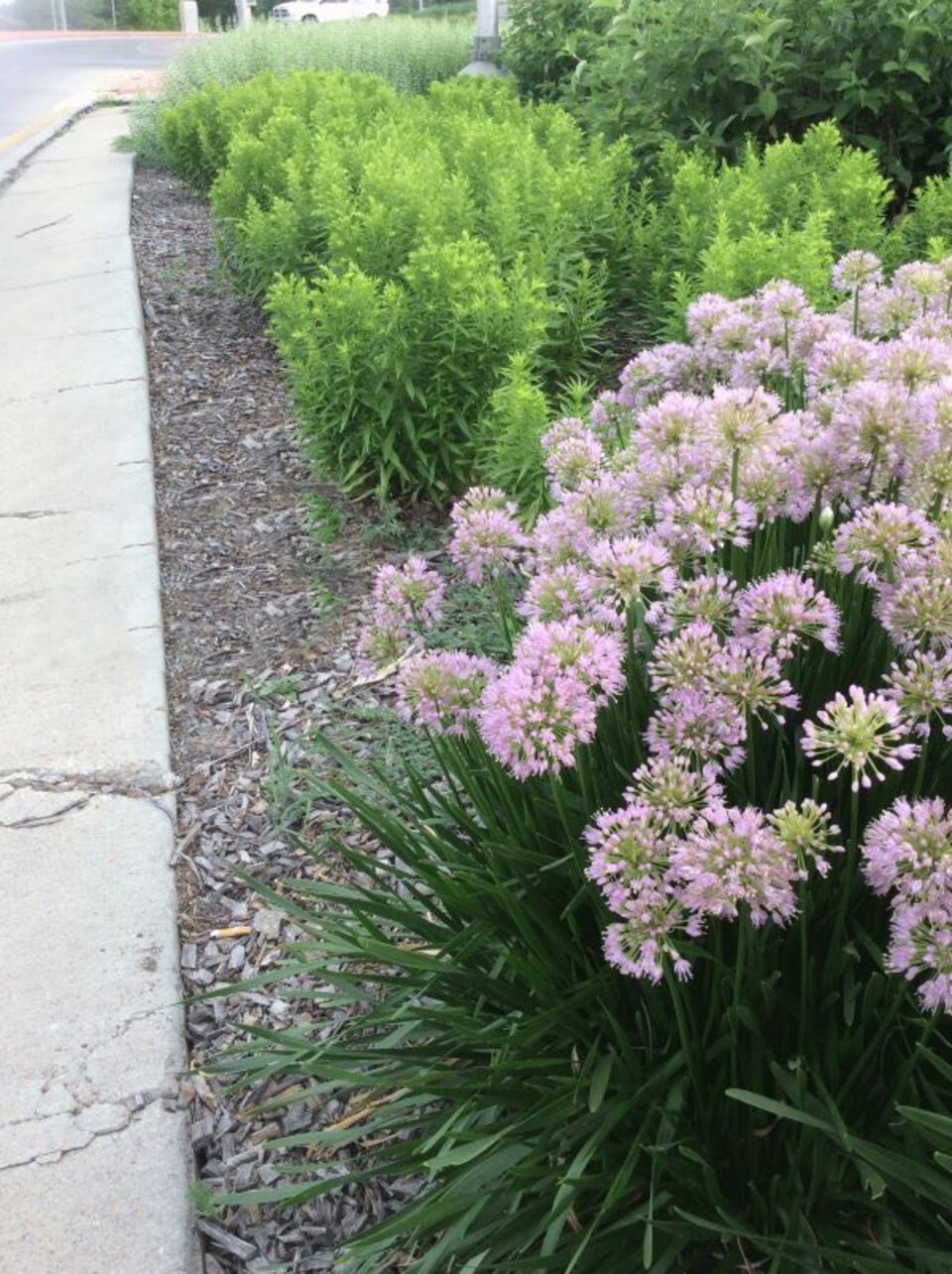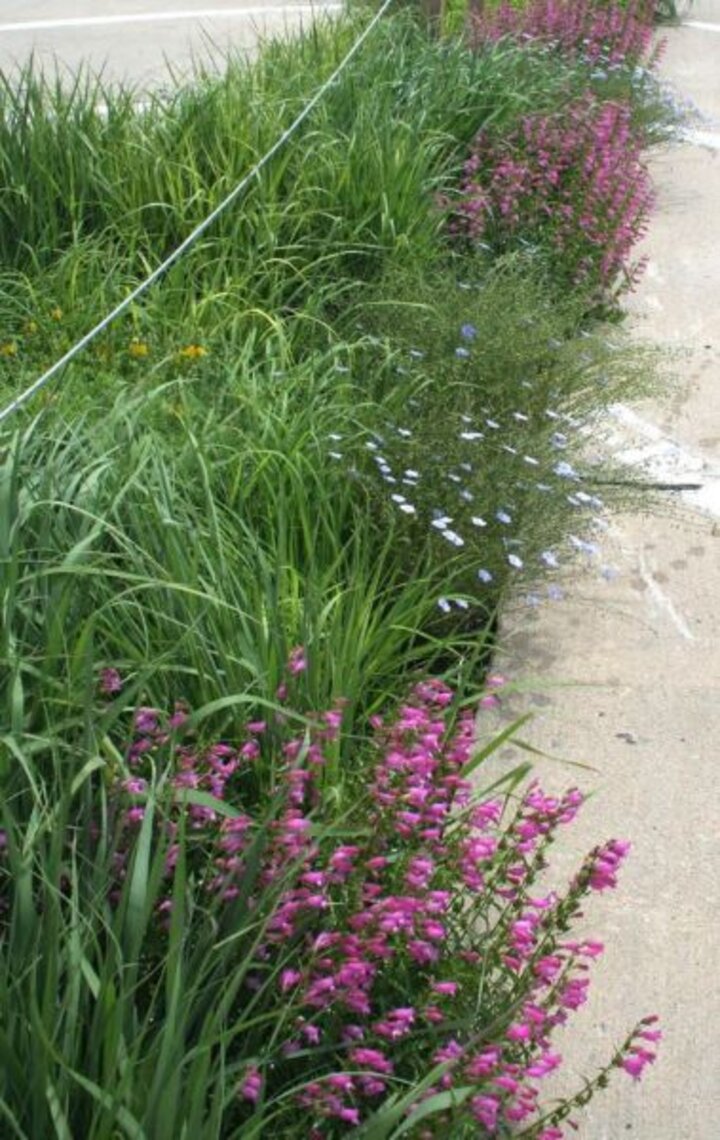Boost Landscape Appeal with a Curb Strip Garden

Many urban landscapes have a forlorn narrow planting strip between the curb and sidewalk, otherwise known as a “hell strip”. Healthy curbside plantings help filter and absorb rainwater, preventing landscape fertilizers and other pollutants from entering storm drains.
No matter what is planted here - turf, trees, shrubs or perennials - they all face many challenges affecting their health and beauty, including those below. These factors must be considered when selecting plant material and, in the case of soil quality, addressed before planting begins if the planting is to be successful.
- Limited rooting area for trees and shrubs
- Poor quality, compacted soil
- Excess salt accumulation in the soil
- High exposure to salty sprays of slush during winter
- Physical damage from winter snow piles
- High levels of foot traffic, resulting in plant damage and increased soil compaction
- Higher levels of reflected heat from hard surfaces in summer and winter
- Higher soil temperatures
Improving Soil Quality
Poor soil is a serious barrier to good plant growth in curb-side gardens and is the result of compaction, low organic matter and excess salt. If plants cannot grow roots into hard soil, they will never grow well or thrive. One method to improve soil physical structure researched by Dr. Nina Bassuk, professor and program leader of the Urban Horticulture Institute at Cornell University, is called the scoop & dump method.
Begin by applying 6 to 8 inches of compost over the top of the compacted soil. Dig up shovels of compacted soil and drop them back to the soil surface. Use the shovel to coarsely break them up. This action physically disrupts the compacted soil and mixes it with the compost, to create veins of compost running through the planting area. Ideally, continue digging and dumping the soil throughout the entire area to a depth of 18 inches.
Do not use a rototiller to mix the compacted soil and compost. The intense mixing and disturbance caused by a tiller does not create the coarse soil particles or “aggregates”, which are the goal of the scoop & dump method. Tilling will further break down any existing soil aggregates.
When finished incorporating the compost, mound the soil over the planting bed. It does not need to be completely smooth - the soil will be covered with mulch after planting to create a pleasing, finished appearance.
Remember - before starting any soil work or planting call Diggers Hotline and have underground utilities located. At least two business days before starting the project, call, 811 or 800-331-5666, or submit a request online, ne1call.com. Mark the planting area with white flags or white paint. Make sure all utilities notified of the project have responded before starting to dig.
City Guidelines
Urban curb plantings are part of the public right-of-way, so are subject to municipal guidelines and restrictions. In Lincoln, homeowners can plant trees, shrubs, turfgrass, ornamental grass, perennials, annual flowers, ground covers or vegetable plants in the curb area. But to preserve traffic sight lines, plants can be no taller than 30 inches above the curb and cannot extend over the edge of curbs, sidewalks, driveways or alleys.
Check with your local municipal or parks & recreation office to find specific guidelines for your community.
Start with the Right Plants

Low-growing native grasses can work well in a full sun hell-strip; they are attractive, sturdy and drought-tolerant once established. Consider little bluestem, blue grama or side-oats grama. Taller native grasses could also work as long as they are not over the 30-inch height guideline.
Potential groundcover plants for sunny areas include prairie smoke, snow-in-summer, plumbago, pussytoes, lamb’s ears, basket-of-gold and perennial geranium; for shady areas try Lamium, Pachysandra and sweet woodruff. Salt-tolerant groundcovers for sunny areas include candytuft, sedum and Artemisia.
Low growing perennials for hot, dry areas include evening primrose, daylily, feverfew, yarrow, purple poppy mallow, prairie phlox, blanket flower, coreopsis, Pasque flower, butterfly milkweed and aromatic or heath aster. Avoid bristly or prickly plants.
After planting, using a natural mulch gives plants an advantage by keeping the soil cooler, conserving moisture and providing additional organic matter as it decomposes. Bark chips, hardwood chips or shredded hardwood mulches are commonly available at hardware stores and garden centers. Apply the mulch directly to the soil, without a layer of landscape fabric beneath it. Mulch should be applied at a depth of 2-3 inches and reapplied in later years as needed to maintain this depth until plants reach full canopy cover over the planting area.
This article was reviewed by Nicole Stoner